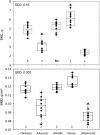Supplementation with Bovine Milk or Soy Beverages Recovers Bone Mineralization in Young Growing Rats Fed an Insufficient Diet, in Contrast to an Almond Beverage
- PMID: 31720556
- PMCID: PMC6829496
- DOI: 10.1093/cdn/nzz115
Supplementation with Bovine Milk or Soy Beverages Recovers Bone Mineralization in Young Growing Rats Fed an Insufficient Diet, in Contrast to an Almond Beverage
Abstract
Background: Nondairy beverages, produced from soy, rice, oat, almond, or coconut, are increasingly being used as alternatives to dairy milk, with the perception that they are healthier and/or more sustainable products than dairy products.
Objective: The aim of this study was to compare the effects of supplementing either bovine milk, soy, or almond-based beverages to young, growing rats fed an intact-protein diet or a diet that had protein substituted with amino acids (AA-diet).
Methods: Three-week-old male Sprague-Dawley rats were randomly assigned to 5 groups (n = 10/group) and fed ad libitum for 4 wk. Two control groups were fed either standard AIN-93G food [20% casein (CN) protein] or AIN-93G with amino acids (AAs) equivalent to CN protein, and water to drink. Three treatment groups were fed AIN-93G AA and supplemented with either bovine ultra-heat treatment (UHT) milk or soy or almond UHT beverages. Rat weight gain and food intakes were recorded. During week 4, body composition was assessed using DEXA to determine lean soft tissue, fat, and bone mass. At trial end, bone biomechanical properties and blood plasma mineral concentrations were measured.
Results: At the end of the trial, animals supplemented with almond beverage were lightest (P > 0.05), with higher plasma calcium concentrations (P > 0.05) and lower bone mineral content (BMC) and bone density (P > 0.05) than animals supplemented with milk or soy beverage. Soy-supplemented animals had similar BMC and bone density compared with milk-supplemented animals, although the soy group gained most weight (P > 0.05) and had the highest fat:lean ratio (P > 0.05) compared with other groups.
Conclusions: In the model tested, supplementing rats with bovine UHT milk and soy UHT beverage provided favorable bone health outcomes. Conversely, almond UHT beverage was not an effective supplement and could be detrimental to bone mineralization and strength outcomes.
Keywords: almond drink; amino acid diet; bone mineralization; milk; soy drink.
Copyright © The Author(s) 2019.
Figures



References
-
- Cashman K. Calcium intake, calcium bioavailability and bone health. Br J Nutr 2002;87(Suppl 2):S169–77. - PubMed
-
- Caroli A, Poli A, Ricotta D, Banfi G, Cocchi D. Invited review: dairy intake and bone health: a viewpoint from the state of the art. J Dairy Sci 2011;94:5249–62. - PubMed
-
- Watson. Alternative beverages -trends to watch [Internet] 2017[cited 9 November, 2017]. Available from: https://www.dairyreporter.com/News/Retail-Shopper-Insights/Packaged-Fact....
-
- Shooter A. Forget cows, we're getting milk from oats and almonds: non-dairy market has grown 155% in just two years [Internet] 2014[cited 12 September, 2018]. Available from: http://www.dailymail.co.uk/femail/food/article-2709071/Forget-cows-getti....
-
- Singhal S, Baker RD, Baker SS. A comparison of the nutritional value of cow's milk and non-dairy beverages. J Pediatr Gastroenterol Nutr 2017;64(5):799–805. - PubMed
LinkOut - more resources
Full Text Sources

